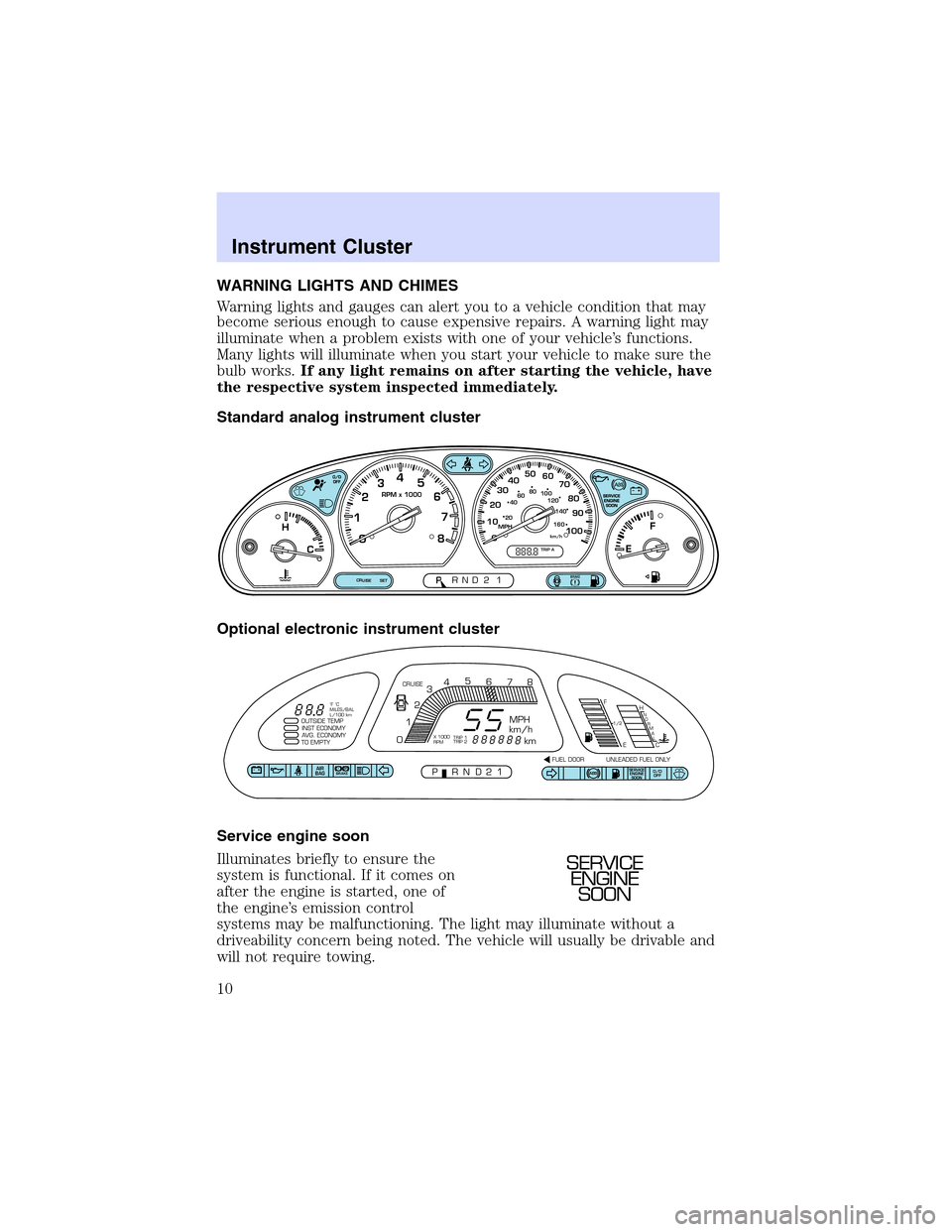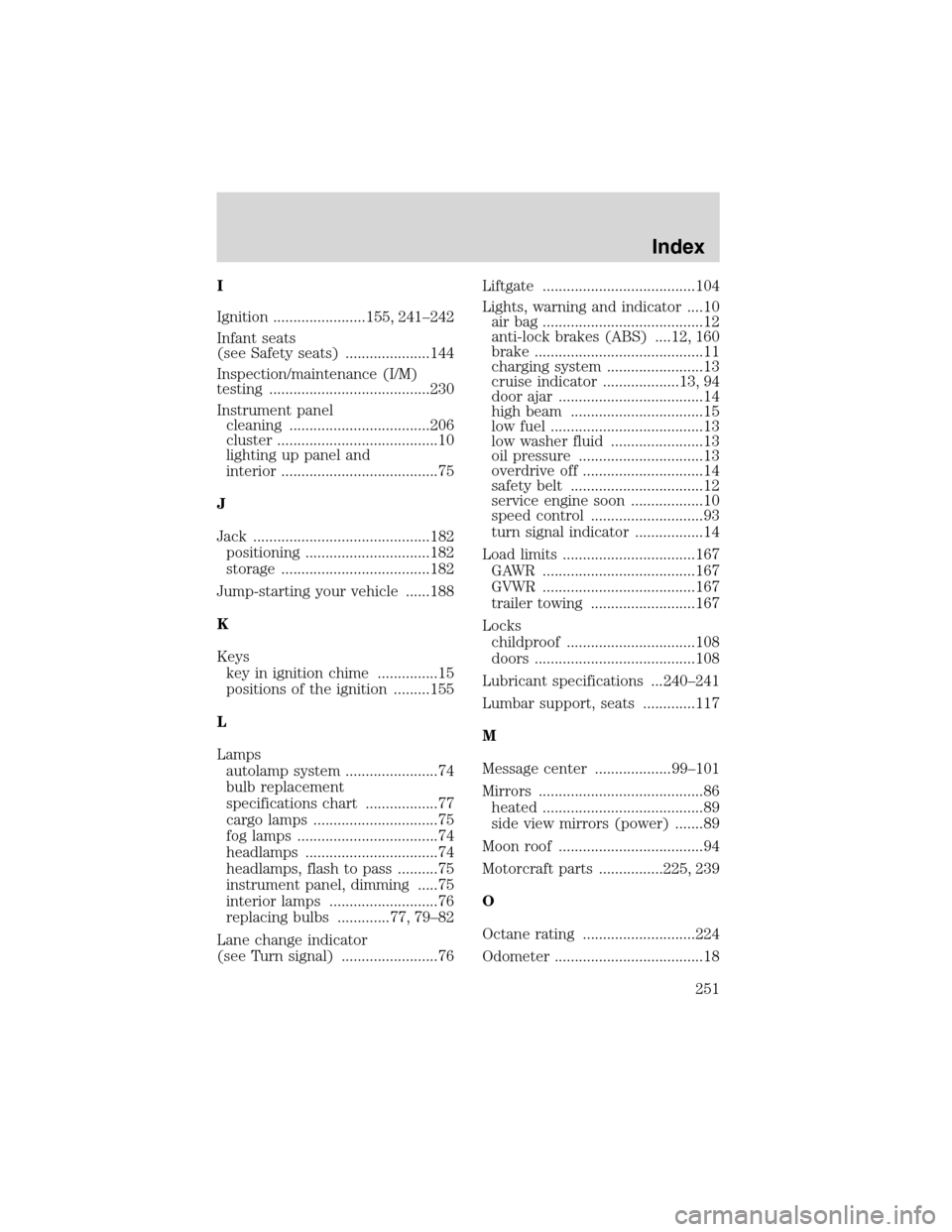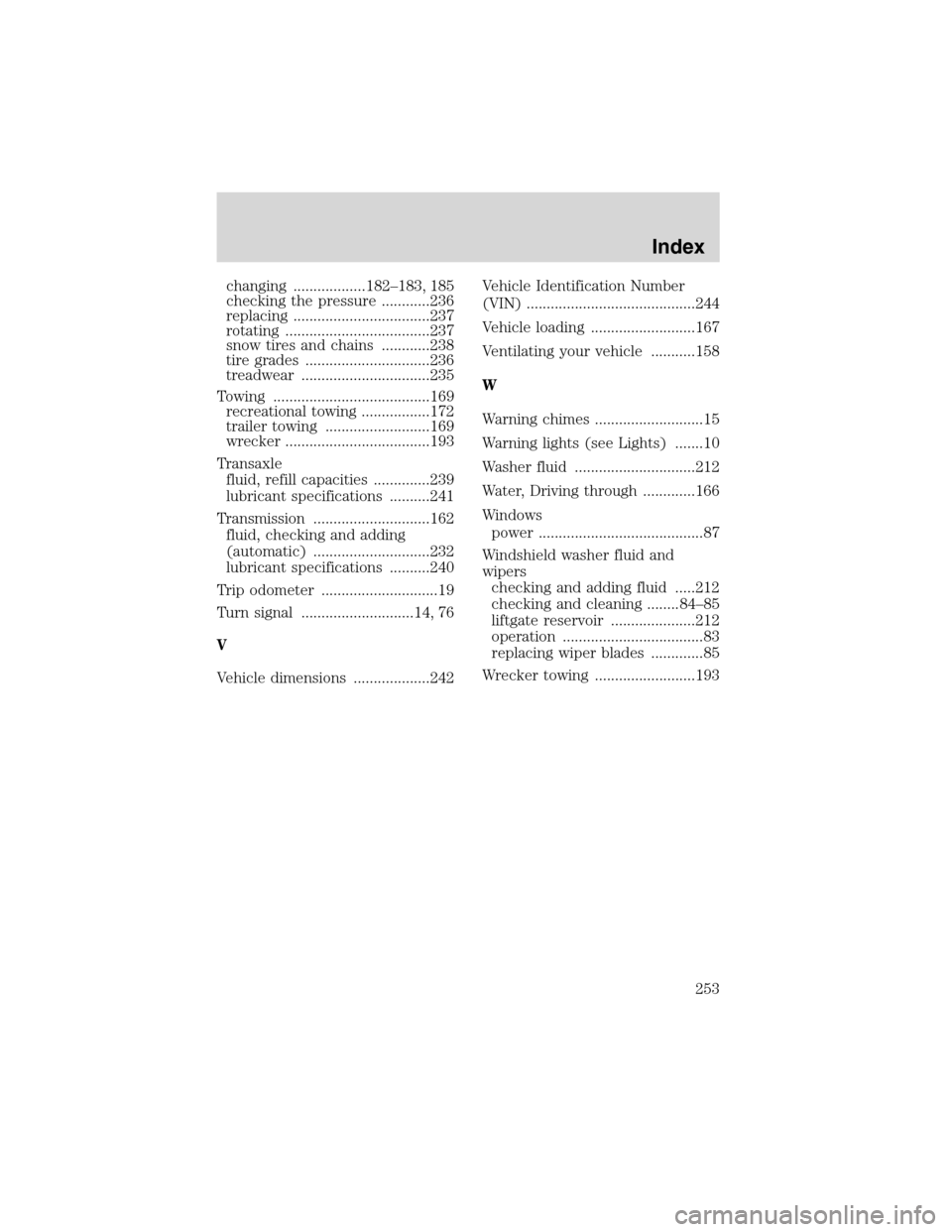warning lights Mercury Villager 2002 Owner's Manuals
[x] Cancel search | Manufacturer: MERCURY, Model Year: 2002, Model line: Villager, Model: Mercury Villager 2002Pages: 256, PDF Size: 1.91 MB
Page 1 of 256

Introduction 4
Instrument Cluster 10
Warning and control lights 10
Gauges 15
Entertainment Systems 20
AM/FM stereo cassette (CD changer compatible) 20
AM/FM stereo cassette with CD 39
Rear seat controls 50
CD changer 53
Climate Controls 58
Manual heating and air conditioning 58
Electronic automatic temperature control 63
Lights 74
Headlamps 74
Turn signal control 76
Bulb replacement 77
Driver Controls 83
Windshield wiper/washer control 83
Steering wheel adjustment 85
Power windows 87
Mirrors 89
Speed control 90
Message center 99
Locks and Security 108
Keys 108
Locks 108
Anti-theft system 109
Table of Contents
1
Page 10 of 256

WARNING LIGHTS AND CHIMES
Warning lights and gauges can alert you to a vehicle condition that may
become serious enough to cause expensive repairs. A warning light may
illuminate when a problem exists with one of your vehicle’s functions.
Many lights will illuminate when you start your vehicle to make sure the
bulb works.If any light remains on after starting the vehicle, have
the respective system inspected immediately.
Standard analog instrument cluster
Optional electronic instrument cluster
Service engine soon
Illuminates briefly to ensure the
system is functional. If it comes on
after the engine is started, one of
the engine’s emission control
systems may be malfunctioning. The light may illuminate without a
driveability concern being noted. The vehicle will usually be drivable and
will not require towing.
km/h0 1020304050
60
70
80
90
100MPH
TRIP A
RPM x 1000
20406080
100
120
140
160
0 1234
5
6
7
8F
H
CE
CRUISE SETPRND2P1
SERVICE
ENGINE
SOONABSAIR
BAGABSO/D
OFF
OUTSIDE TEMP
INST ECONOMY
AVG. ECONOMY
TO EMPTY
PRND21FUEL DOOR UNLEADED FUEL ONLY CRUISE
MPH
km/h
km
F
EH
C
1/2N
O
R
M
A
L
012345
6
78
P!BRAKE
X 1000
RPMTRIP 1
TRIP 2 ˚F ˚C
MILES/BAL
L/100 km
SERVICE
ENGINE
SOON
Instrument Cluster
10
Page 155 of 256

STARTING
Positions of the ignition
1. OFF/LOCK, shuts off the engine
and all accessories/locks the steering
wheel, gearshift lever and allows key
removal.
2. ACC, allows the electrical
accessories such as the radio to
operate while the engine is not
running.
3. ON, all electrical circuits
operational. Warning lights
illuminated. Key position when driving.
4. START, cranks the engine. Release the key as soon as the engine
starts.
Preparing to start your vehicle
Engine starting is controlled by the powertrain control system. This
system meets all Canadian Interference-Causing Equipment standard
requirements regulating the impulse electrical field strength of radio
noise.
When starting a fuel-injected engine, avoid pressing the accelerator
before or during starting. Only use the accelerator when you have
difficulty starting the engine. For more information on starting the
vehicle, refer toStarting the enginein this chapter.
Extended idling at high engine speeds can produce very high
temperatures in the engine and exhaust system, creating the risk
of fire or other damage.
Do not park, idle, or drive your vehicle in dry grass or other dry
ground cover. The emission system heats up the engine
compartment and exhaust system, which can start a fire.
Do not start your vehicle in a closed garage or in other enclosed
areas. Exhaust fumes can be toxic. Always open the garage door
before you start the engine. SeeGuarding against exhaust fumesin
this chapter for more instructions.
4
3
2
1
Driving
155
Page 230 of 256

Readiness for Inspection/Maintenance (I/M) testing
In some localities, it may be a legal requirement to pass an I/M test of
the on-board diagnostics system. If your“Check Engine/Service Engine
Soon”light is on, refer to the description in theWarning lights and
chimessection of theInstrument Clusterchapter. Your vehicle may not
pass the I/M test with the“Check Engine/Service Engine Soon”light on.
If the vehicle’s powertrain system or its battery has just been serviced,
the on-board diagnostics system is reset to a“not ready for I/M test”
condition. To ready the on-board diagnostics system for I/M testing,
follow the procedure described below:
1. Allow the engine to cool to ambient temperature (the engine coolant
temperature gauge indicator will point to C).
2. Start the engine and let it run until it reaches normal operating
temperature (the engine coolant temperature gauge indicator will be
near the center of the normal area between H and C).
3. Accelerate the vehicle to 88 km/h (55 mph), then quickly release the
accelerator pedal completely for at least six seconds.
4. Quickly depress the accelerator pedal for a moment, then drive the
vehicle at a speed of 86 to 96 km/h (53 to 60 mph) for at least five
minutes.
5. Bring the vehicle to a complete stop.
6. Accelerate the vehicle to 55 km/h (35 mph), and maintain the speed
for 20 seconds.
7. Repeat steps five and six at least three times.
8. Accelerate the vehicle to 88 km/h (55 mph), and maintain the speed
for at least three minutes.
9. Bring the vehicle to a complete stop and turn the engine off.
10. Repeat steps one through nine at least one more time.
If step one through eight are interrupted, repeat the preceding step. Any
safe driving mode is acceptable between steps. Once started, do not turn
off the engine until step seven is completed.
Maintenance and Specifications
230
Page 251 of 256

I
Ignition .......................155, 241–242
Infant seats
(see Safety seats) .....................144
Inspection/maintenance (I/M)
testing ........................................230
Instrument panel
cleaning ...................................206
cluster ........................................10
lighting up panel and
interior .......................................75
J
Jack ............................................182
positioning ...............................182
storage .....................................182
Jump-starting your vehicle ......188
K
Keys
key in ignition chime ...............15
positions of the ignition .........155
L
Lamps
autolamp system .......................74
bulb replacement
specifications chart ..................77
cargo lamps ...............................75
fog lamps ...................................74
headlamps .................................74
headlamps, flash to pass ..........75
instrument panel, dimming .....75
interior lamps ...........................76
replacing bulbs .............77, 79–82
Lane change indicator
(see Turn signal) ........................76Liftgate ......................................104
Lights, warning and indicator ....10
air bag ........................................12
anti-lock brakes (ABS) ....12, 160
brake ..........................................11
charging system ........................13
cruise indicator ...................13, 94
door ajar ....................................14
high beam .................................15
low fuel ......................................13
low washer fluid .......................13
oil pressure ...............................13
overdrive off ..............................14
safety belt .................................12
service engine soon ..................10
speed control ............................93
turn signal indicator .................14
Load limits .................................167
GAWR ......................................167
GVWR ......................................167
trailer towing ..........................167
Locks
childproof ................................108
doors ........................................108
Lubricant specifications ...240–241
Lumbar support, seats .............117
M
Message center ...................99–101
Mirrors .........................................86
heated ........................................89
side view mirrors (power) .......89
Moon roof ....................................94
Motorcraft parts ................225, 239
O
Octane rating ............................224
Odometer .....................................18
Index
251
Page 253 of 256

changing ..................182–183, 185
checking the pressure ............236
replacing ..................................237
rotating ....................................237
snow tires and chains ............238
tire grades ...............................236
treadwear ................................235
Towing .......................................169
recreational towing .................172
trailer towing ..........................169
wrecker ....................................193
Transaxle
fluid, refill capacities ..............239
lubricant specifications ..........241
Transmission .............................162
fluid, checking and adding
(automatic) .............................232
lubricant specifications ..........240
Trip odometer .............................19
Turn signal ............................14, 76
V
Vehicle dimensions ...................242Vehicle Identification Number
(VIN) ..........................................244
Vehicle loading ..........................167
Ventilating your vehicle ...........158
W
Warning chimes ...........................15
Warning lights (see Lights) .......10
Washer fluid ..............................212
Water, Driving through .............166
Windows
power .........................................87
Windshield washer fluid and
wipers
checking and adding fluid .....212
checking and cleaning ........84–85
liftgate reservoir .....................212
operation ...................................83
replacing wiper blades .............85
Wrecker towing .........................193
Index
253